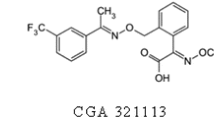Abstract
The present paper reports the in vitro and in vivo bioefficacy of different doses of a combination of fungicide, fluopyram 20 %+tebuconazole 20 %-40 SC against anthracnose disease of chilli (Capsicum annuum L.) and their pre-harvest intervals pertaining to two different application rates. In vitro bioefficacy studies revealed the best control (79.3 %) at 250 mg kg−1 against 68.4 % control under field conditions. A sample preparation method based on ethyl acetate extraction and estimation by LC–MS multiple reaction monitoring was validated in chilli fruits. Residue dissipation studies were conducted in field at single and double doses. The residues of both fluopyram and tebuconazole on all the sampling days were below the maximum residue limit (European Union) and maximum permissible intake estimated on the basis of the prescribed acceptable daily intakes. The combined bioefficacy and residue dynamics information will support label-claim of this combination of fungicide for the management of anthracnose in chilli and facilitate its inclusion in good agricultural package of practices.


Similar content being viewed by others
References
Tong N, Bosland PW (1999) Capsicum tovarii, a new member of the Capsicum complex. Euphytica 109(2):71–72
Anon (2010). FAO Annual Report. p147
Osuna-García JA, Wall MW, Waddell CA (1998) Endogenous levels of tocopherols and ascorbic acid during fruits ripening of New Mexican-type chilli (Capsicum annuum L.) cultivars. J Agric Food Chem 46(12):5093–5096
Ramachandran N, Reddy MK, Rathnamma K (2007) Current status of chilli Anthracnose in India. Abstract of papers. First International Symposium on Chili Anthracnose, Seoul, Korea, Sept 17–19, Hoam Faculty House, Seoul National University, p. 26.
Smith BJ, Black LL (1990) Morphological, cultural, and pathogenic variation among Colletotrichum species isolated from strawberry. Plant Dis 74(1):69–76
Alexander SA, Waldenmaier CM (2002) Management of Anthracnose in Bell Pepper. Fungicide and Nematicide Tests [Online]. New Fungicide and Nematicide Data Committee of the American Phytopathological Society 58:49
Lewis IML, Miller SA (2003) Evaluation of fungicides and a biocontrol agents for the Control of anthracnose on green pepper fruit, Nematicide Test Report [Online]. New Fungicide and Nematicide Data Committee of the American Phytopathological Society 58:62
DG-SANCO. EU Pesticide Database. Author: Brussels, Belgium, 2008. http://ec.europa.eu/sanco_pesticides/public/index.cfm. Accessed on 10th Mar 2014
Zentmeyer GA (1955) A laboratory method for testing soil fungicides with Phytophthora cinnamomi, a test organism. Phytopathology 45:398–404
Vincent JM (1947) Distortion of fungal hyphae in the presence of certain inhibitors. Nature 159:850
Mayee CD, Datar VV (1986) Phytopathometry. Technical Bulletin I, M. A. U., Parbhani, p 29
Wheeler BEJ (1969) An introduction to plant disease. Wiley, London, p 301
Commission of the European Communities. Directorate General for Agriculture (1997) General recommendations for the design, preparation, and realization of residue trials, 7029/VI/95 rev.5. http://ec.europa.eu/food/plant/protection/resources/app-b.pdf. Accessed on 10th Mar 2014
Thompson M, Ellison SL, Wood R (2002) Harmonized guidelines for single laboratory validation of methods of analysis. IUPAC technical report. Pure Appl Chem 74:835–855
Method validation and quality control procedures for pesticide residue analysis in food and feed. Document No. SANCO/10684/2009, 1–42, http://ec.europa.eu/food/plant/protection/resources/qualcontrol_en.pdf. Accessed on 10th Mar 2014
European Commission. Opinion of the Scientific Committee on Food on Capsaicin. http://ec.europa.eu/food/fs/sc/scf/out120_en.pdf. Accessed on 10th Mar 2014
Brown GE, Chambers M (1998) Evaluation of tebuconazole for control of postharvest diseases of Florida citrus. Proc Fla State Hortic Soc 111:263–267
Anon (2009) European Patent Application. Application number: 09151244.2 Bulletin 2009/38
Singh A, Mohan C, Pawan K (2011) Evaluation of new fungicides against anthracnose and powdery mildew of grapevine. Plant Dis Res 26(2):188
Lachaise H, Labourdette G, Rieck H, Steiger D (2011) Fluopyram: efficacy and beyond on problematic diseases. J Pestic Sci 36(1):159
Ishii H, Miyamoto T, Ushio S, Kakishima M (2011) Lack of cross-resistance to a novel succinate dehydrogenase inhibitor, fluopyram, in highly boscalid-resistant isolates of Corynespora cassiicola and Podosphaera xanthii. Pest Manag Sci 67(4):474–482
European Commission Decision 2002/657/EC implementing Council Directive 96/23/EC concerning the performance of analytical methods and the interpretation of results. (2002) Off J Eur Committee L221: 8–36
Saha S, Thekkum Purath AS, Jadhav, Loganathan M, Banerjee K, Rai AB (2013) Bioefficacy, residue dynamics and safety assessment of the combination fungicide trifloxystrobin 25% + tebuconazole 50%-75 WG in managing early blight of tomato (Lycopersicon esculentum Mill.). J Environ Sci Health Part B 49(2):134–141
Acknowledgments
The authors are grateful to the Directors of NRCG, Pune and IIVR, Varanasi for their ardent support during the tenure of the study.
Conflict of Interest
There is no conflict of interest regarding the research work.
Author information
Authors and Affiliations
Corresponding author
Rights and permissions
About this article
Cite this article
Saha, S., Jadhav, M.R., Ahammed Shabeer, T.P. et al. Safety Assessment and Bioefficacy of Fluopyram 20 %+Tebuconazole 20 %-40 SC in Chilli, Capsicum annum L. Against Anthracnose Disease. Proc. Natl. Acad. Sci., India, Sect. B Biol. Sci. 86, 359–366 (2016). https://doi.org/10.1007/s40011-014-0450-4
Received:
Revised:
Accepted:
Published:
Issue Date:
DOI: https://doi.org/10.1007/s40011-014-0450-4




